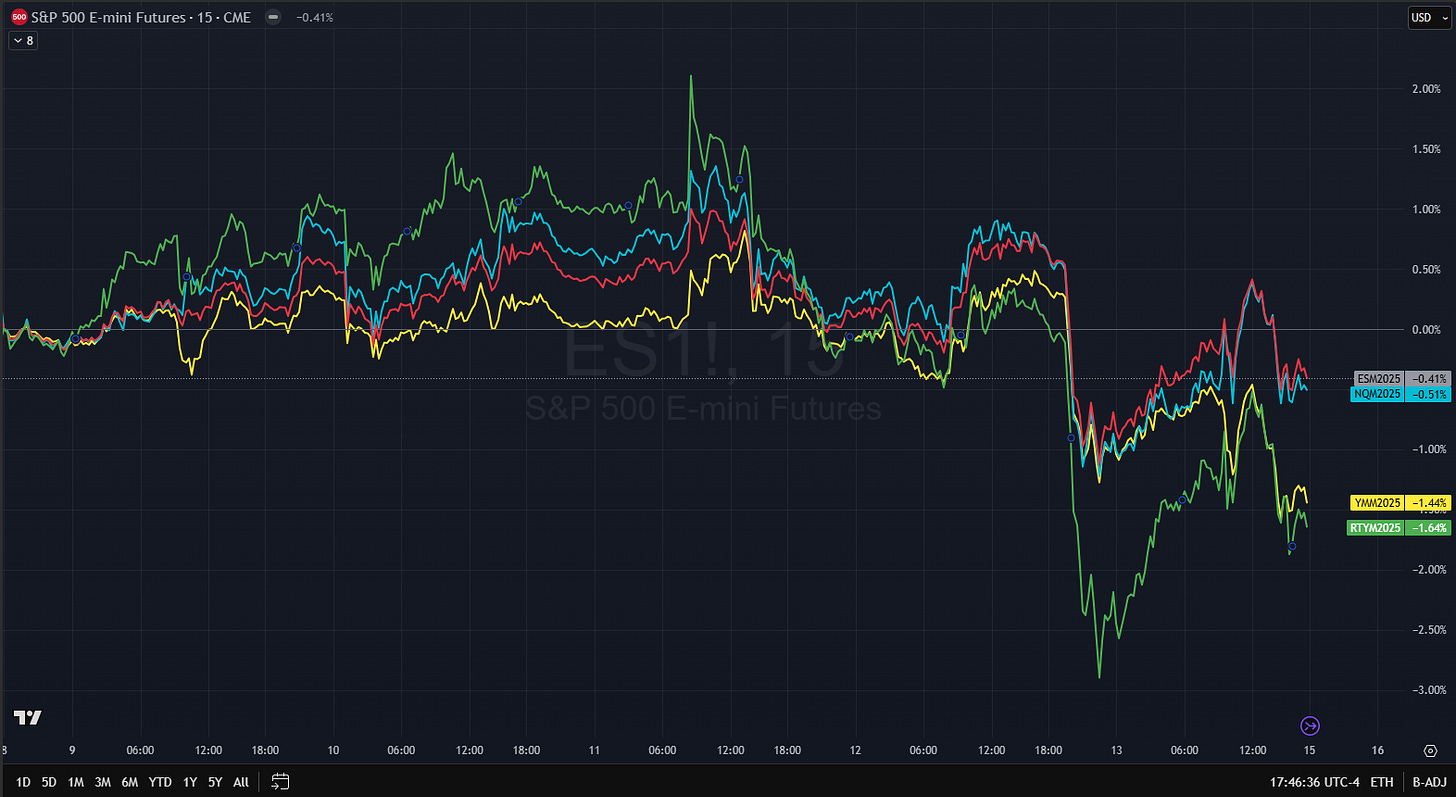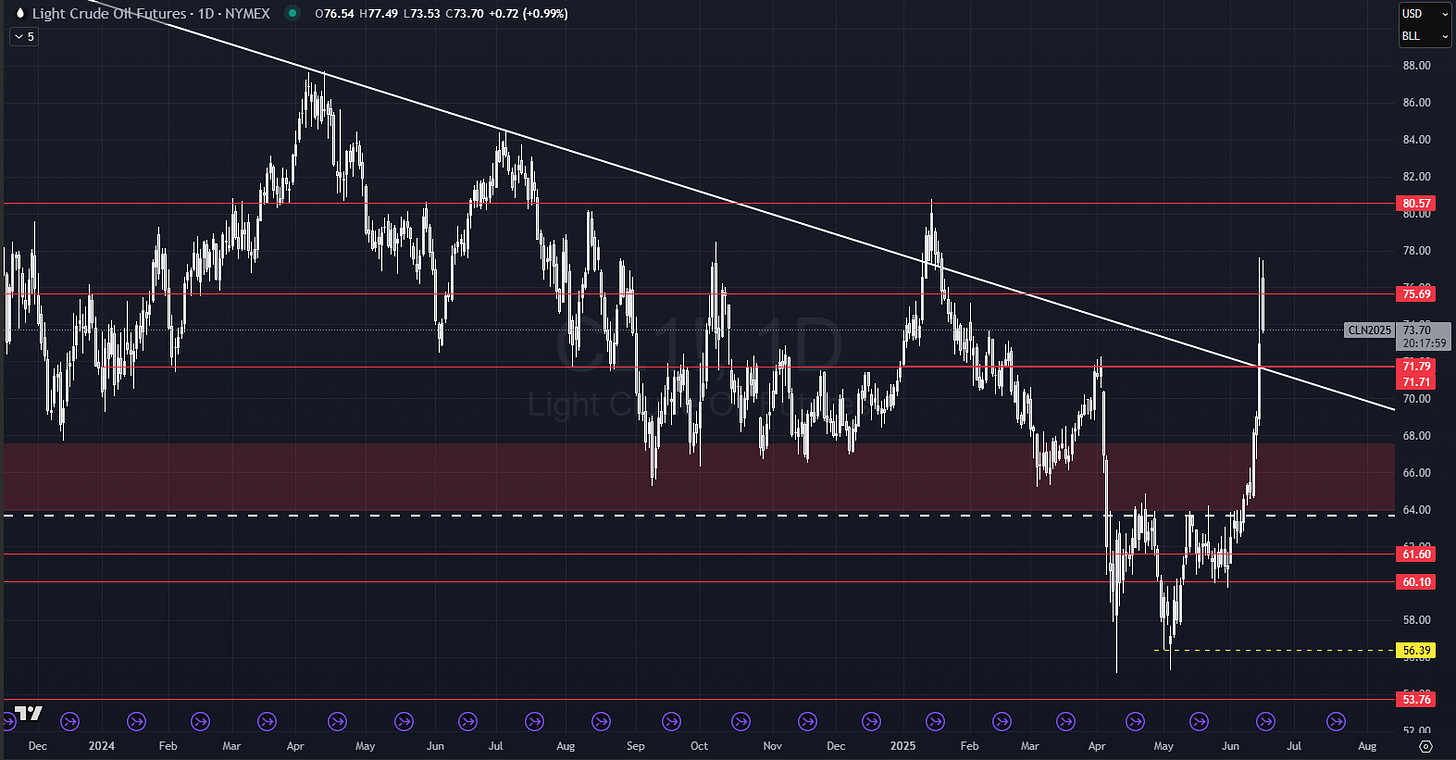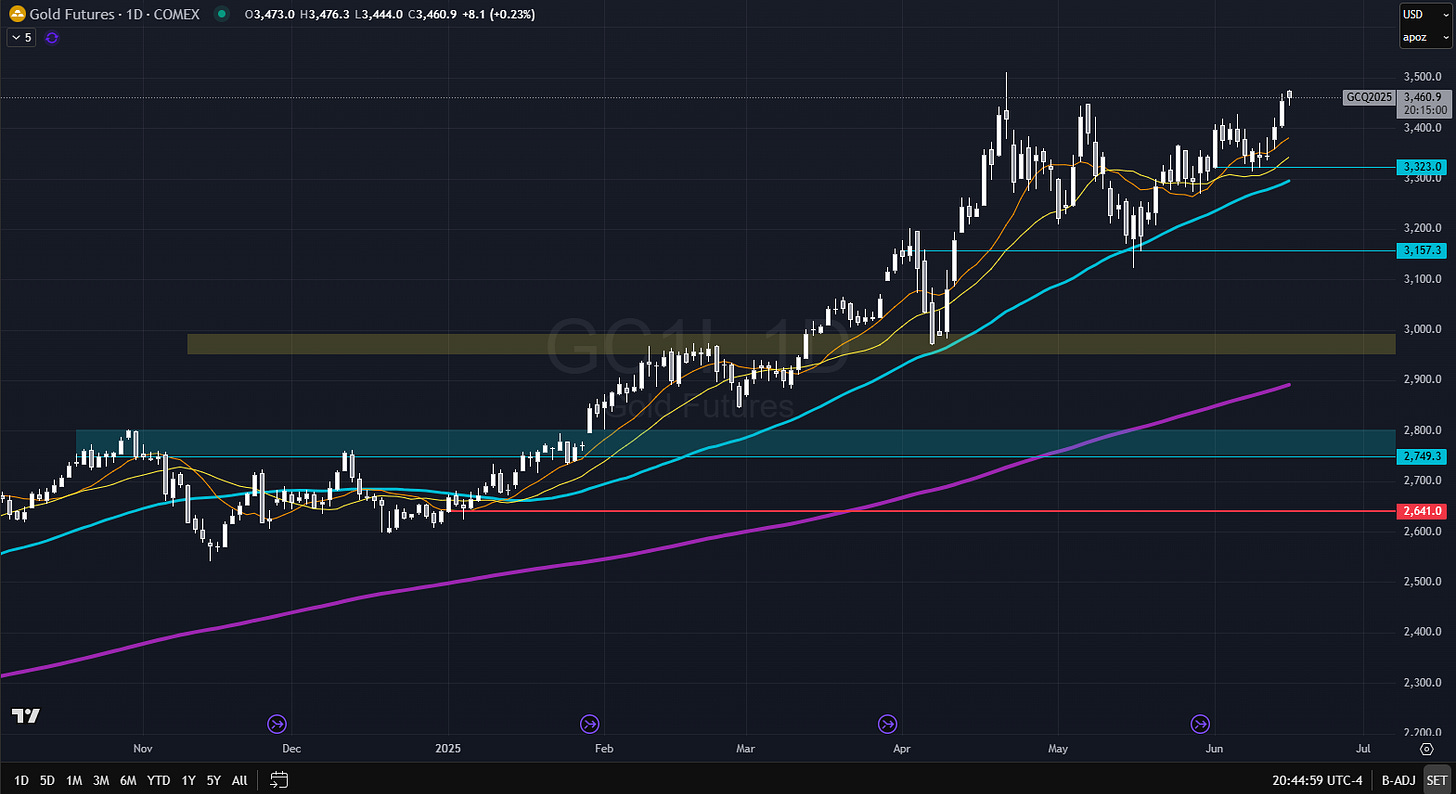Inflation Softens, Tempers Don’t: A Tactical Guide to the Week
Weekly Roadmap for 06/15-06/21
A Calm Before the Fireworks?
Before we get into the week ahead, a quick word to all the dads and father figures out there, Happy Father’s Day. Whether you’re leading a household, mentoring the next generation, or just trying to sneak in some quiet time before Monday’s open, you’re appreciated. Here's to a day of well-earned recognition.
Now, turning to what’s coming down the pipeline…
Over the next couple of weeks, we’ll be publishing two fresh research primers. The first focuses as a series intro to Robotics & Automation, and the second is a Healthcare Tech / Biotech update, an evolution of our original healthcare outlook from last year. Both themes are increasingly central to market structure and worth revisiting as catalysts continue to unfold.
A Look Back: Muted Markets, Loud Headlines
Markets meandered last week. The S&P 500 finished down about 36bps, a modest fade after trading more than 1% higher earlier in the week. Small caps fared worse, the Russell 2000 dropped 1.42% after an intraday peak nearly 2% higher. In other words, it was a week defined by reversal, not momentum.
What changed?
The big inflection came as geopolitical tensions spiked mid-week. Israel launched fresh strikes on Iranian territory, with some reports suggesting these weren’t just nuclear-targeted, but more broadly aimed at destabilizing key regime infrastructure. A planned U.S.-Iran meeting was swiftly cancelled, and markets quickly priced in the added risk premium.
This Week: Quieter Calendar, But Eyes on the Fed
Looking ahead, it's a short and relatively quiet week. U.S. markets are closed Thursday, but we do have a few key events to monitor:
FOMC Meeting (Wednesday): While no major surprises are expected, tone and language will be scrutinized.
Retail Sales: A decent read-through on the consumer.
Jobless Claims: Still the cleanest weekly pulse check on labor trends.
Beyond that, the primary “event risk” remains the Middle East. The direction of headlines here may dominate intraday moves more than economic data.
Inflation: A Temporary Reprieve?
Last week’s CPI and PPI prints were encouraging:
Headline CPI: In line at 2.4%, up slightly from 2.3%
Core CPI: A beat, 2.8% vs. 2.9% expected
PPI: Also slightly softer than forecast
It’s worth noting: these figures do not yet reflect the full impact of recent tariffs. That lag effect means we’ll likely see upward pressure filter into the next round of inflation reports (due in July, covering June data). For now, though, the inflation narrative got a breather.
U.S.-China: Deal on Paper, But Little Has Changed
Trade talks between the U.S. and China wrapped up in London with a loose agreement to implement terms originally set back in Geneva. Highlights:
China to ease rare-earth export restrictions
U.S. to relax certain tech export controls
Existing tariffs remain
Fentanyl-specific tariffs stay in place unless China shows progress
In short, this was more “maintenance of status quo” than a breakthrough.
One Thing That Didn’t Get Enough Attention...
Buried beneath all the noise was a staggering fiscal update:
The U.S. posted a record $316 billion deficit in May, pushing the fiscal year-to-date total to $1.365 trillion. That’s already pacing ahead of FY2024’s $1.202 trillion at this point last year.
Bessent made headlines by revising the administration’s fiscal target:
New Deficit-to-GDP goal: <4%
Original target (earlier this year): <3%
It’s a quiet concession that austerity is no longer on the table. In practice, the administration’s path forward looks more like this: grow fast, inflate nominal GDP, and hope that productivity outruns spending…
Your classic “run it hot” strategy.
The math doesn’t work any other way unless massive spending cuts suddenly become politically viable (spoiler: they won’t).
Index Check-In: Technical Levels, Reversals, and Geopolitical Pressure
S&P 500 (SPX / SPY)
Markets sold off into the latter part of the week as Middle East tensions ramped up, and while the S&P only finished the week down about 35bps, the internals tell a more nuanced story. Despite SPX being just 1% off recent highs, only 44% of stocks remain above their 20-day moving averages. That speaks to an underlying softness and shows the rally isn’t broadly overextended, more of a neutral backdrop than an outright overbought condition.
SPX remains above its 21-day, but bulls struggled repeatedly last week at the 6050 level. A sustained break above that threshold is likely needed for another leg higher. Conversely, if tensions overseas escalate and SPX continues to roll over, the 200-day moving average at 5800 becomes the line in the sand. A breakdown below would increase downside momentum and potentially lead to a full gap-fill, which interestingly coincides with the “China tariff pause” level.
Nasdaq-100 (QQQ)
The Qs had a relatively tame week on the surface, closing down a modest 50bps after being up over 1% early on. The reversal, like everything else, was triggered by the Israel-Iran conflict. Still, earlier in the week QQQ notched fresh local highs and came within striking distance (100bps) of new all-time highs before fading.
Support-wise, the 21-day sits just below and may offer a first line of defense. Beyond that, 500 remains the key level right around the 200 day moving average.
To the upside, 540 continues to be the big resistance zone, a ceiling that’s held since both the December and February pullbacks. If bulls can break above with conviction, we’ll likely see new highs, driven by the continued dominance of Mag-7 leaders like MSFT / NVDA / ORCL, all of whom reaffirmed the durability of the AI trade last week.
Russell 2000 (IWM)
Small-caps took the worst of the damage last week, finishing down 1.42% after being up nearly 2% earlier on. The reversal was sharp, triggered by the geopolitical flare-up, a rally in crude (a headwind for small caps), and declining bond prices, another pain point for rate-sensitive sectors.
There’s also been some hand-wringing around the last few jobless claims reports, which showed elevated prints. But much of that appears to be seasonal… The underlying hard data hasn’t cracked, and even soft data is beginning to rebound. Throw in last week’s cooler CPI, and the near-term macro setup remains digestible. The real inflation pressure from tariffs likely won’t show up until July.
Technically, IWM gapped higher on CPI day and topped out right at the 200-day which it failed to hold, closing the week back down. This could shape up as a backtest of the breakout from a couple weeks ago. Going forward:
To stay constructive: Bulls need to hold above 200. That range aligns with the late-May lows, 50-day, and 200-week, a high-confluence support zone.
To break higher: Clear the 200-day and push into 223 (2025’s yearly open). Light positioning and seasonal tailwinds could help, especially if deregulation themes start to kick in during the back half of the year.
Macro Watch: Dollar, Bonds & the Shifting Safe-Haven Story
US Dollar: The Safe-Haven That Wasn’t
Last week was another telling moment for the U.S. dollar, and not in a good way. Despite escalating tensions in the Middle East, the dollar barely budged, closing Friday up just 30bps and struggling to hold above a 98-handle. Historically, this kind of geopolitical volatility would have sent DXY ripping higher. Not this time.
The key takeaway? The dollar’s safe-haven credibility continues to erode, and last week offered more evidence that the path of least resistance remains lower. In fact, DXY broke through its multi-year range now sits at a critical technical juncture.
Throw in softer-than-expected inflation data and a bump in rate-cut expectations (markets are now pricing in two cuts before year-end), and the case for further dollar weakness becomes even clearer. The once-reliable bid under the dollar is weakening and that may be by design.
A softer dollar helps narrow trade deficits, and frankly, this administration isn’t likely to stand in the way of that trend.
That said, if we do get a bounce, holding 100 is a critical level. Until then, expect pops to be faded. On any short-term dollar strength, the Yen remains the most likely underperformer.
Bonds: Whiplash Trading & Inflation Crosscurrents
Bonds had quite the ride last week. First, they rallied on softer CPI and strong auction results. Then, they gave it all back by week’s end, even with rising geopolitical tensions. That might seem counterintuitive, but here’s the key: war is inflationary.
Initial flight-to-safety bids were quickly replaced by inflation fears, especially as oil prices ticked higher. In a world already wrestling with tariff-driven price pressure, any conflict that tightens commodity supply chains only reinforces upside inflation risk.
Looking ahead to this week, FOMC takes center stage, and while no rate change is expected, the updated dot plot could stir markets. Powell may lean slightly dovish, especially if he frames recent inflation as a “one-time price shock” rather than a persistent trend (a narrative we’ve heard from some Fed officials recently). But unless labor data deteriorates or inflation plunges again, the Fed is likely to stick to its “wait and see” script.
Bond Market Range: Still Stuck, Still Emotional
Let’s zoom out. Despite all the noise, recession fears in April and inflation concerns now, bonds have been in a giant range for nearly three years. The recent action has been choppy but contained:
Interim range: 4.20–4.25% on the low end, 4.65–4.70% on the high end
Wider range: 3.65–3.80% to the downside, 4.75–5.00% to the upside
Right now, we’re in no-man’s land, not oversold, not overbought. That makes it a tough environment to take a directional stance unless something breaks out of that range.
And it’s worth noting: between fiscal overextension (last month’s $316B deficit), BBB-level credit pressures, sticky inflation risk heading into late 2025, and now Middle East volatility, the upside in bonds likely remains capped, unless we get a sharp deterioration in hard economic data.
Geopolitical Tensions, Energy Volatility & Opportunity in Shipping and Gold
Middle East Escalation: High Stakes, Measured Reactions
Tensions between Israel and Iran ratcheted higher last week as Israel launched strikes on Iranian sites. Though officially framed as attacks on nuclear infrastructure, the broader strategic goal appears to be regime destabilization. From Israel’s view, a nuclear-capable Iran is an existential threat, and they’re not just targeting centrifuges anymore…
Iran responded with a familiar threat: shutting down the Strait of Hormuz, which moves about 20% of global oil. But any serious follow-through would be self-defeating, Iran relies on the Strait for its own exports. Militarily, the U.S. would likely step in fast, and politically, such a move would damage ties with China and India, two of Iran’s biggest crude customers.
The U.S., for now, is holding back. A planned diplomatic meeting with Iran was cancelled, with the administration reiterating that denuclearization is the non-negotiable starting point. While the official stance is “hands-off,” it wouldn’t take much for that to change if the situation worsens.
One wrinkle? Trump voiced concerns last week over rising oil prices, which may create an incentive for future negotiations with Iran to de-escalate and push crude lower, especially heading into election season. That said, while tensions drive short-term spikes, it’s important to remember the oil market remains well supplied, making extended price surges harder to sustain.
Crude Oil: Watching the $80 Level Closely
We saw a technical breakout in crude last week. Futures topped out near $77.50, and heading into this week, price action will again hinge on weekend developments in the Middle East.
Despite the volatility, crude still trades below the January highs (~$80). That level remains a key pivot. A clean breakout above would suggest a new trend leg; otherwise, this may just be another headline-driven bounce.
Gold: A Testament to Trend Strength
Gold had a strong week, continuing it’s strength and benefiting from both geopolitical volatility and renewed concerns over U.S. fiscal credibility. May’s record $316 billion deficit added fuel to the fire. Even after tariff-related uncertainty was removed back in April, gold has held near highs, a powerful signal.
If gold can punch through $3,500, it opens the door to new highs. On a pullback, support should show up near $3,300. If those levels don’t hold, the next key support is down near $3,150.
Bottom line: as long as real yields remain capped and the U.S. credibility gap persists, dips in gold are likely to be bought.
Closing Thought:
We’re in a regime where headlines matter more than usual… and yet, beneath the noise, the market continues to favor structurally sound companies, steady macro data, and trend persistence. Stay tactical, stay selective, and stay tuned.
-BSR
Disclaimer:
Remember, this is not financial advice. You are fully responsible for your own decisions!
The information provided on this website/Substack is for informational purposes only. While it is believed to be reliable, Blackshore Research does not guarantee its completeness or accuracy. This content is not an offer or solicitation to buy any financial instrument. The information and terms on these pages can change without notice. Unauthorized use of Blackshore Research’s websites and systems is strictly prohibited. This includes data scraping, unauthorized access, password misuse, or improper use of posted information. Your eligibility for certain services will be determined by Blackshore Research and its affiliates. Investment services are not FDIC-insured and carry investment risks, including potential loss of principal. The proprietary information from Blackshore Research or third-party providers is for individual use only and must not be redistributed or transferred without prior written consent from Blackshore Research.









